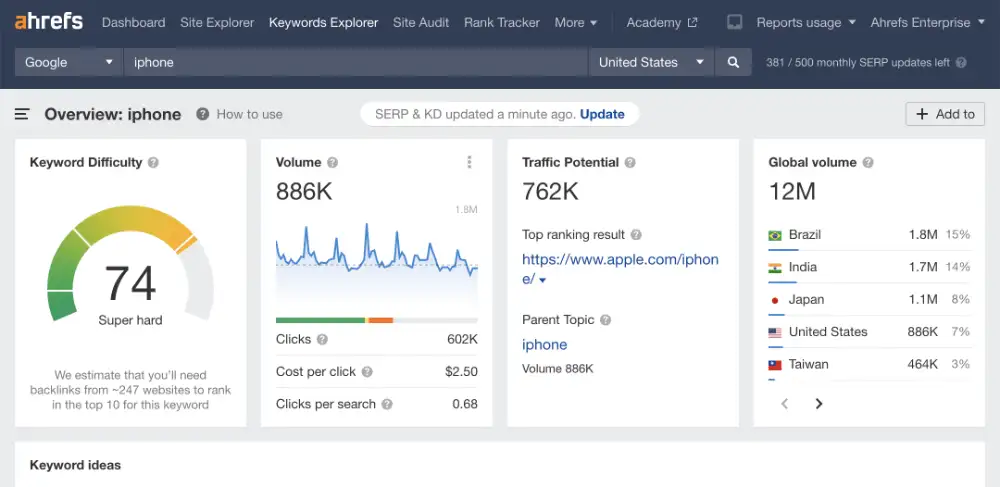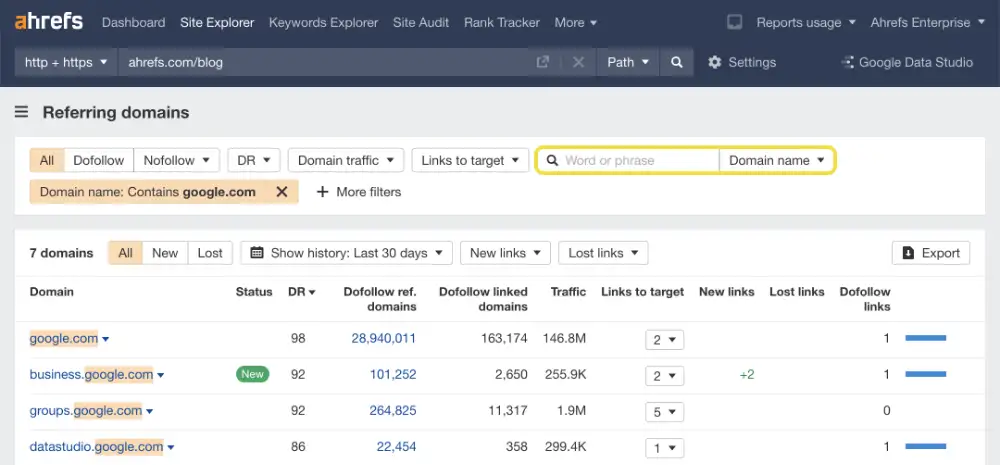Guide to Writing SEO-Optimised Blog Posts
Our blog, ‘How to Write Blog Posts for SEO,’ will help you understand the fundamentals of crafting blog posts that will impact the SERPs. Creating impactful blog posts that rank well in search results requires a mix of strategic planning and engaging writing. At Blue Rock Digital, we follow a comprehensive approach to ensure our content reaches and resonates with our target audience.
Why Blog Posts Matter
Writing quality blog posts enhances SEO, drives traffic, and establishes your brand as an authority. Successful posts combine engaging writing with valuable information, encouraging readers to continue engaging with your content.
Research Phase
Keyword Research: Use tools like Ahrefs to identify keywords that reflect user intent and have high search volume. Determine parent topic keywords and explore related phrases to address all relevant pain points. Keyword research forms the backbone of your SEO strategy. You can tailor your content to meet their needs by understanding what your audience is searching for. Focus on long-tail keywords as they often have less competition and are more specific, thus attracting a more targeted audience. Additionally, consider search intent, whether it is informational, navigational, transactional, or commercial investigation.
Competitor Analysis: Examine top-ranking articles to understand what works. Look at titles, headings, content length, and overall formatting for insights. This will help you identify gaps in their content that you can fill. Understanding the strengths and weaknesses of your competitors’ content allows you to create something more valuable. Pay attention to the types of media they use, the depth of their content, and the engagement they receive. This will give you a benchmark to aim for and potentially exceed.
Crafting the Post
Structure and Length: Break down content into easily navigable sections with clear headings. Each section should serve a purpose, and the overall word count should align with successful competitors. The balance between detailed and concise writing is based on the section’s importance. The structure of your post is crucial for readability and SEO. Use H1 for the title, H2 for main sections, and H3 for sub-sections. This hierarchy helps search engines understand the importance of each section. Additionally, it aids readers in navigating your content, making it more likely they will stay on your page longer, positively impacting your SEO.
Engaging Titles: Titles should be descriptive and engaging and reflect the type of content. Use emotive language to grab attention. A compelling title should include your primary keyword and promise value or evoke curiosity. For instance, instead of “Tips for Writing Blog Posts,” a title like “10 Proven Tips to Write Blog Posts that Captivate and Convert” is more compelling. Incorporate numbers, power words, and questions to make your titles more appealing.
Writing Process
Introduction: Hook the reader by outlining what they will learn and why it matters. Establish authority and build interest from the start. Your introduction should address a pain point and promise a solution. For example, if you’re writing about SEO tips, start with a statistic about how many websites fail to optimise their content effectively and then promise to provide actionable tips to avoid those pitfalls.
Content Delivery: Write conversationally, explaining concepts clearly and addressing potential questions. Use a mix of short, punchy sentences and varied vocabulary. Break up text with bullet points, lists, and quotes to keep the reader engaged. Additionally, incorporate storytelling elements to make your content more relatable and memorable. Share personal experiences, case studies, or hypothetical scenarios to illustrate your points.
Visual Aids: Include visuals like images, infographics, or videos to support and enhance the text. Visuals break up the text and can make complex information easier to understand. Use charts, graphs, and infographics to illustrate data points. Ensure that all visuals are optimised for SEO by using descriptive filenames and alt text. Videos can also enhance your content, especially for tutorials or how-to guides. Embed relevant videos and provided transcripts to make the content accessible and SEO-friendly.
SEO Integration: Sprinkle keywords naturally throughout the content without overstuffing. Focus on delivering value and meeting user intent. Keyword stuffing can harm your SEO efforts. Instead, use synonyms and related terms to help search engines understand the context of your content. Additionally, use internal and external links to provide further value and context to your readers. Internal links help keep readers on your site longer, while external links to reputable sources can enhance your content’s credibility.
Post-Writing
Review and Edit: Ensure the content flows well, is error-free, and meets SEO best practices. Use tools to check readability and keyword integration. Editing is a critical step that should not be rushed. Tools like Grammarly help identify grammatical errors, while Hemingway can assess readability. Additionally, perform a manual review to ensure the content makes sense and flows logically. Check for consistency in tone and style, and verify that all links work correctly.
Call to Action: End with a solid call to action that encourages readers to take the next step, whether subscribing to your newsletter, sharing the post, or contacting you for services. A compelling call to action (CTA) is essential for converting readers into customers or subscribers. Use action-oriented language and create a sense of urgency. For example, “Sign up today to receive exclusive SEO tips!” is more effective than “Subscribe to our newsletter.”
Ongoing Optimisation: SEO is not a one-time task. Regularly update your blog posts to keep them relevant and improve their performance. Use analytics tools to track performance and identify areas for improvement. Look for new keywords to target, update outdated information, and refresh visuals to keep your content current. Regular updates signal to search engines that your content is fresh and relevant, which can improve your rankings.
Keyword Research in Detail
Keyword research is the first and arguably the most crucial step in writing an SEO-optimised blog post. This process involves identifying the terms and phrases that potential readers use when searching for content related to your topic. Here’s a deeper look into how to conduct adequate keyword research:
Using Tools for Keyword Research: Tools like Ahrefs, SEMrush, and Google Keyword Planner can help you identify keywords your audience is searching for. These tools provide data on search volume, keyword difficulty, and competition, essential metrics for selecting the right keywords.
Understanding Search Intent: Search intent refers to the reason behind a user’s search query. Understanding whether the purpose is informational, navigational, transactional, or commercial investigation can help you tailor your content to meet user expectations. For instance, searching for “best SEO tools” indicates commercial investigation intent, suggesting the user is considering a purchase and needs comparison information.
Long-Tail Keywords: Long-tail keywords are longer and more specific keyword phrases. They typically have lower search volumes but higher conversion rates because they cater to users with a clear intent. For example, “how to optimise blog posts for SEO” is a long-tail keyword that targets users explicitly looking for SEO tips for blog posts.
Competitor Analysis for Keywords: Analysing competitors helps you understand their target keywords and how well they rank for them. Use tools like Ahrefs to see the keywords your competitors are ranking for and identify any gaps that you can exploit. Look at the keywords in their meta tags, headings, and throughout their content.
Competitor Analysis Expanded
Competitor analysis is more than just looking at keywords. It involves a comprehensive review of your competitors’ content to understand what makes it successful. Here’s how to conduct an in-depth competitor analysis:
Evaluating Content Quality: Examine the quality of your competitors’ content. Look at how they structure their posts, the depth of information they provide, and the readability of their content. High-quality content tends to rank better because it provides value to readers.
Identifying Content Gaps: Look for topics or subtopics your competitors have not covered or covered in detail. These gaps allow you to create content that fills those voids and attracts an audience looking for that information.
Engagement Metrics: Analyse the engagement metrics on your competitors’ posts, such as comments, shares, and backlinks. High engagement indicates that the content resonates with the audience. Look at the type of content that gets the most engagement and consider how to create similar or better content.
Backlink Analysis: Backlinks are a significant factor in SEO. Use tools like Ahrefs to see where your competitors are getting their backlinks. Identify high-quality sites linking to your competitors and reach out to those sites with your valuable content to gain backlinks.
Structuring Your Post for Success
The structure of your blog post plays a crucial role in its readability and SEO performance. Here’s a deeper look into how to structure your post effectively:
Using Headings and Subheadings: Headings (H1, H2, H3) help break down your content into manageable sections. They not only improve readability but also help search engines understand the structure of your content. Each section should have a clear heading that describes its content. Use H2 for main sections and H3 for sub-sections.
Introduction: Your introduction should be compelling and concise. It should hook the reader and clearly state what they can expect to learn from your post. A good introduction addresses a common pain point and promises a solution, encouraging the reader to continue.
Body Content: The body of your post should be well-organised and flow logically. Use short paragraphs, bullet points, and lists to make the content more digestible. Each section should build on the previous one, guiding the reader through the topic.
Summary and CTA: Conclude your post with an overview of the critical points and a solid call to action. Encourage readers to take the next step, whether subscribing to your newsletter, sharing the post, or contacting you for services.
Writing Engaging Content
Engaging content keeps readers on your page longer, positively impacting your SEO.
Creating impactful blog posts that rank well in search results requires a mix of strategic planning and engaging writing. We hope you enjoyed reading our blog on how to write blog posts for SEO. At Blue Rock Digital, we follow a comprehensive approach to ensure our content reaches and resonates with our target audience.



















